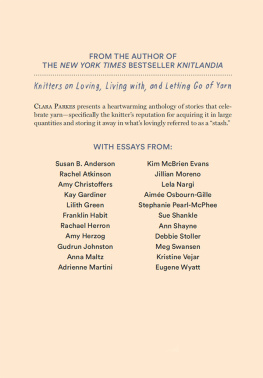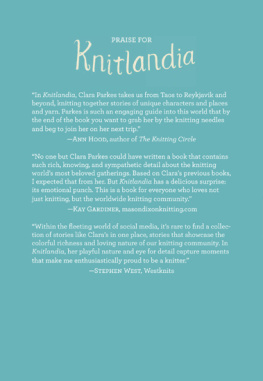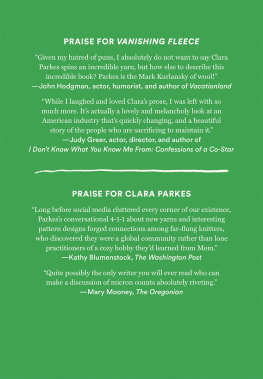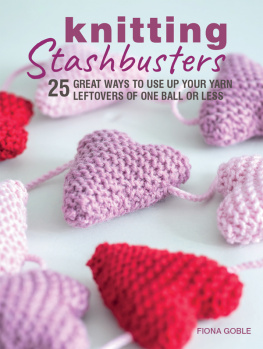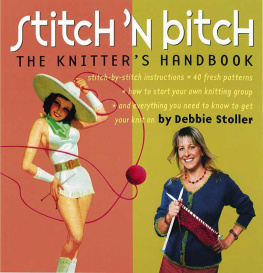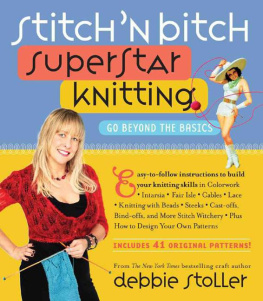
Editor: Shawna Mullen
Production Manager: Kathleen Gaffney
Library of Congress Control Number: 2017930251
ISBN: 978-1-4197-2704-7
eISBN: 978-1-68335-162-7
Copyright 2017 Clara Parkes
Cover illustration by Chris Silas Neal
Published in 2017 by Abrams Press, an imprint of ABRAMS. All rights reserved. No portion of this book may be reproduced, stored in a retrieval system, or transmitted in any form or by any means, mechanical, electronic, photocopying, recording, or otherwise, without written permission from the publisher.
Abrams books are available at special discounts when purchased in quantity for premiums and promotions as well as fundraising or educational use. Special editions can also be created to specification. For details, contact specialsales@abramsbooks.com or the address below.

ABRAMS The Art of Books
115 West 18th Street, New York, NY 10011
abramsbooks.com
CONTENTS
Perhaps there is no beginning and end to yarn, just a constant heartbeat of energy, a long chain of shifting shapes, from lamb to landfill, that started with the Big Bang and wont end until the next Big Bang. All we have... is the here and now. The yarn in our hands and on our needles at this very moment: Thats our stash.
CLARA PARKES, WHEN ITS GONE, ITS GONE
FOREWORD
My father was a professional musician for his entire adult career. He played oboe and English horn in an orchestra, and that meant he was always making reeds. For this, he had a room filled with tools with names like mandrels and ballots and plaques and staples, along with a well-worn cutting block, spools of thread in rich, shiny colors, and a little blob of beeswax. It was like Santas workshop, if Santa were a woodwind player.
I grew up understanding the importance of tools and supplies to a creative person.
Yarn is the reed with which we knitters make music. We, too, have our rooms filled with tools that help us carry on our craftthings with names like swifts and ball-winders and DPNs and circular needles and yarn bowls. Collectively, they make up what we call our stash.
The specific tools may vary, but the room will always have yarn. Yarn is as essential to us as paint is to the artist, flour to the baker, soil to the gardener. We can improvise on most of the tools, tying string into a stitch marker, sanding down a bamboo chopstick in a pinch. But without yarn, our hands are idle.
As many kinds of yarn exist as there are people on earth. Each has a distinct structure and texture and behavior and ideal use. With so many options, and so many directions dictated by each choice, we require a healthy supply of materials in order to do our work.
A formal definition of healthy I cannot provide. It differs for each person. Most knitters dwell somewhere between Gosh, I love my yarn and Am I a hoarder?
We stash so that we can start a project at 2:00 AM if so inclined, but the relationship between stitcher and yarn goes far beyond simply being prepared. A yarn stash is a declaration of self-esteem. It is Virginia Woolfs room of ones own, a significant financial stake in the ground that says, My passion is worthwhile.
Asking a knitter what he or she plans on doing with the yarn he or she just bought is like asking a squirrel what it plans on doing with that nut it just buried under a pile of leaves. Obviously we plan on using it. Now? Later? For what? How can we know? Our main priority is simply to get that yarn safely back home and stored away in our stash. Well know when we need it.
I once asked readers in a poll, Without moving from where you are, can you see any yarn? While 50 percent of the respondents said no, its worth noting that 50 percent said yes. Which means that half of the worlds knitters could, at any moment, toss you a skein of yarn without putting on their shoes.
Could you say the same thing about golfers or woodworkers or people who go spelunking on weekends? Without moving from where they are seated, how many of them could see golf clubs, or lathes, or whatever it is spelunkers use?
But yarn is far more than the sum of its parts, more than just a means to an end. Yarn holds hope and energy and history; it is a declaration, a question, an obsession, and a love story.
This book is a carefully selected collection of stories, statistics, tips, and manifestos on the subject of stashspecifically (but not always), the knitters reputation for acquiring large quantities of yarn and storing them away for future use. The writers celebrate the meaning we attribute to yarn, the stories we let it keep, and the place it holds in our homes and in our lives.
The pieces in this collection cover the comical to the earnest, the lighthearted to the deeply philosophical, in a celebration of the how, why, when, and what weve accumulated (and let go of) over the years. They open our eyes to what stash means to each of us, both individually and collectively.
Youll find a full spectrum of voices, including knitwear designers and publishers, dyers and yarn store owners, along with a sheep farmer, an illustrator, a romance novelist, a handspinner, a Fulbright scholar, and a licensed clinical social worker to help us answer that common nagging fear: Do I have a problem? We hear from a knitting humorist, a PhD-wielding feminist publisher, the daughter of a shepherd, a globetrotting textile artist based in London, and a globetrotting designer currently based in western Massachusetts who may very well have moved again by the time you read this.
As varied as the voices in this collection are, they all have one fundamental thing in common: With the exception of our sheep farmer, Eugene, who gets a pass because he grows the fibers that make our world go round, every person in here knits. A lot. Which means that they coexist with a strong and distinct notion of stash every single day.
If you are a knitter who struggles to explain to others why your yarn stash means what it does to you, why it deserves so much more than a dismissive eyeroll, this book can be a start.
If you struggle not, if you love your stash and tend to it daily, let this book be your celebration.
And if you are a stash-aware nonknitter who wants to understand why your beloved relates to yarn the way he or she does, why that guest room simply must be turned into the stash room, read on.
All stitchers, you dont need me to tell you what our stashes mean. You live it. Im preaching to the choir. In fact, this book is the choir, each voice singing loud and proud.
Clara Parkes
INHERITING FROM ELIZABETH ZIMMERMANN
BY MEG SWANSEN
I am the youngest of Arnold and Elizabeth Zimmermanns three children. One evening when I was about seven, my mother divided a large sheet of paper into three vertical columns; she wrote one of our names at the top of each column. The paper was then passed around to each of us in turn, and we were to write downone item at a timewhatever family artifacts we wished to inherit. Being so young, it didnt occur to me to put down the Things of Great Value that belonged to my family (as my brother and sister were doing). My very first choice was the dictionary. It was a grand dictionarytoo large for me to liftand it lived on its own lectern in the living room. The words
Next page
